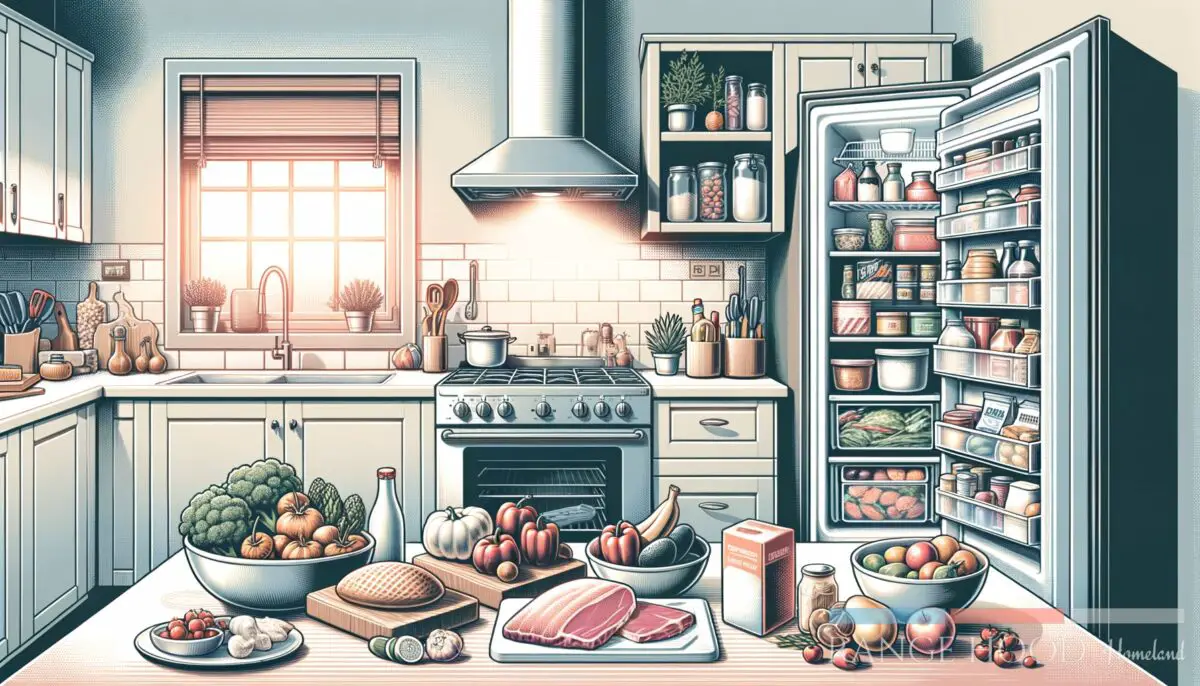Just like choosing the best range hoods can be a game-changer for your culinary creations, understanding the difference between proper and poor kitchen ventilation can significantly impact your home’s air quality. Why does your kitchen need good ventilation? You’ll discover how a well-ventilated kitchen can enhance your cooking experience and health.
If you are a visual learner, check out this video titled ‘The Importance of Ventilation in the Kitchen | How to Improve Kitchen Ventilation?’
Key takeaways
- Utilize your range hood with every cooking session to ensure contaminants are removed.
- Choose the right type of range hood for your kitchen’s layout and cooking habits.
- Regular maintenance, including filter replacement, is crucial for optimal performance.
- Incorporate more ventilation methods like air purifiers and strategic fan use.
Why good ventilation is key for your home kitchen
Good ventilation in your home kitchen is crucial for several reasons, primarily for removing unwanted odors, heat, and air pollutants generated during cooking. Cooking can produce a significant amount of moisture, grease, and potentially harmful substances that, if not properly ventilated, can settle on surfaces and affect indoor air quality.

Here’s a list that highlights why you should prioritize kitchen ventilation:
- It ensures a comfortable cooking environment by eliminating excessive heat and moisture.
- Reduces the risk of mold and mildew, which can damage your home and affect health.
- Prevents lingering odors that can make your home smell like last night’s dinner well into the next day.
A properly designed kitchen ventilation system will not only protect your health but also protect the structural integrity of your kitchen. Whether it’s through using exhaust fans, range hoods that vent outside, or ensuring that your kitchen has adequate natural airflow, there are multiple ways to achieve effective ventilation.
To learn more about how kitchen ventilation affects not just your cooking space but your entire home’s environment, check out this article on the role of kitchen ventilation in indoor air quality.
Just between us, while I’m no Michelin-star chef or a building engineer, I’ve always been someone who appreciates a good, clear, and fresh environment, especially in the kitchen where magic (and sometimes chaos) happens. It’s fascinating to me how such a simple thing as switching on the range hood fan can dramatically improve the quality of the air we breathe in our homes.
An acquaintance once told me about a dinner party they hosted where the kitchen turned into a smokescreen because they forgot to turn on the exhaust fan. It’s kind of like that scene in “Julie & Julia” where Julie attempts to master French cooking and ends up with her apartment filled with smoke – a perfect yet humorous example of why proper kitchen ventilation is no laughing matter.
“Enhancing your kitchen’s ventilation goes beyond installing the right range hood. Investing in air purifiers and utilizing fans strategically can significantly improve air quality management, ensuring a healthier, more comfortable cooking environment.”
For more insights, I found this guide on choosing the right range hood for your kitchen super helpful and eye-opening.
Continuing from our discussion on the importance of kitchen ventilation, let’s explore more details that will further highlight why this aspect of home design and maintenance deserves our attention.
COSMO COS-63190S Wall Mount Range Hood

COSMO COS-63190S Wall Mount Range Hood
Choosing the right type of range hood
Finding the perfect range hood can be quite the task, but understanding the types available can simplify the process. A family of four produces up to a gallon of grease annually from cooking, underscoring the need for efficient kitchen ventilation.
Under-cabinet hoods
Ideal for kitchens with limited space, under-cabinet hoods save room while effectively removing smoke and odors. They are mounted underneath a cabinet above the stove, making them an integral part of kitchen design that’s both functional and space-efficient.

Wall-mounted and island hoods
For kitchens with a cooktop located on a kitchen island, an island hood is your go-to, providing powerful ventilation directly from the center of your space. Wall-mounted hoods, on the other hand, fit kitchens where the stove is against the wall.
They act not only as functional pieces but also as statement design elements.
Ductless and insert hoods
Ductless hoods recirculate air through a filter, making them a versatile option for homes where ductwork installation is impractical. Insert hoods are built into the cabinetry for a seamless look, perfect for custom kitchens.
Each type has its own set of advantages tailored to different kitchen layouts and needs. For a deeper dive into how to select the best range hood, considering ductwork and aesthetics, visit this guide on adding a range hood into your kitchen design.
Key terms when shopping for range hoods
Understanding the language of ventilation technology can empower you to make informed decisions.
CFM ratings and BTU
The performance of range hoods is measured in CFM (Cubic Feet per Minute), indicating the volume of air it can move. Matching this with your range’s BTU (British Thermal Units) is crucial for optimal performance.
A high BTU cooking surface requires a hood with a high CFM rating for adequate ventilation.
Blower types and ducting
Range hoods come with different blower types and ducting configurations. The effectiveness of your ventilation system largely depends on keeping duct runs short and straight.
Also, consider the blower type; internal, inline, or external options significantly impact the ventilation capacity and noise level.

The importance of capture area and mounting height
Capture area and proper mounting height directly influence a range hood’s efficiency. Ensuring the width of the range hood matches or exceeds the width of the cooktop ensures optimum pollutant capture. Likewise, correct mounting height prevents the escape of contaminants and ensures no heat damage to the unit.
Before we dive into more details, let’s look at a table that summarizes the crucial aspects of kitchen ventilation:
| Aspect | Detail |
|---|---|
| Gallons of grease/year | 1 (for a family of four) |
| BTU to CFM matching | Essential for removing heat and contaminants efficiently |
| Blower types | Internal, inline, external |
| Effective ducting | Keep duct runs short and straight for better performance |
| Capture area importance | Width of range hood should match or exceed the width of the cooktop |
| Optimal mounting height | Prevents the escape of contaminants; ensures no heat damage |
With these specifics in mind, selecting the right ventilation system for your kitchen becomes a clearer and more focused task. Let’s continue to explore the nuances of kitchen ventilation and how it plays into the overall health and safety of your home environment.
Navigating the world of kitchen ventilation can feel like a labyrinth if you’re not armed with the right information. To help guide you through, I’ve compiled a straightforward list of dos and don’ts.
These nuggets of wisdom will ensure your kitchen remains a haven of good air quality, keeping unwanted elements at bay while maintaining the integrity and functionality of your range hood and ventilation systems.
| Do | Don’t |
|---|---|
| Use your range hood every time you cook | Forget to turn on the ventilation |
| Keep duct runs short and straight | Allow ducts to bend or extend unnecessarily |
| Match the hood width to the cooktop width | Install a hood too small for your cooktop |
| Regularly clean filters and ductwork | Neglect maintenance and cleaning duties |
| Consult with professionals for installation | Attempt complex installations on your own |
More ventilation tips
Enhancing your kitchen’s ventilation goes beyond installing the right range hood. Here are some actionable steps to ensure you’re maximizing the effectiveness of your kitchen’s air quality management:
- Open windows when possible: This invites fresh air in and aids in circulating air, reducing the concentration of contaminants.
- Utilize fans strategically: Placing fans near windows can help draw fresh air into the room and push stale air out.
- Invest in air purifiers: High-efficiency particulate air (HEPA) cleaners can complement your ventilation system by trapping airborne particles.
- Keep the kitchen clean: Regularly cleaning surfaces and appliances, including the range hood, helps minimize grease and dust that can hinder ventilation efficacy.
- Perform regular maintenance: Regular checks of your ventilation system can prevent issues before they escalate, maintaining optimal function.
Efficient kitchen ventilation is a blend of the right equipment, strategic practices, and regular maintenance. These tips aim to provide clarity and guidance on creating a safer, healthier, and more enjoyable cooking environment.
Frequently asked questions (FAQ)
How usually should I replace my range hood filter?
It’s recommended to replace or clean (if using reusable filters) your range hood filter every 3 to 6 months. However, the frequency can vary based on how usually you cook and the type of cooking.
For heavy use or when cooking with a lot of grease, you might need to replace or clean the filter more frequently.
Can I install a range hood myself?
While some simpler range hood models can be a DIY project, it’s best to consult with or hire professionals for more complex installations, especially those involving external ducting. Professional installers ensure your range hood is installed correctly and efficiently, avoiding any potential hazards or inefficiencies.
Are all range hoods vented to the outside?
No, not all range hoods vent to the outside. There are ductless or recirculating range hoods that filter the air through charcoal filters and recirculate it back into the kitchen.
While these are easier to install and maintain, they may not be as effective as vented models in removing all contaminants from your kitchen.
Final thoughts
In wrapping up, it’s clear that good kitchen ventilation should never be an afterthought. From selecting the right range hood type to understanding the importance of replacing filters, and adding more ventilation tips, we’ve covered a comprehensive guide to help ensure your kitchen remains a safe, healthy, and enjoyable space to cook in.
Remember, the goal is not just to eliminate odors and smoke but to ensure the air quality in your home is at its best.
What steps are you planning to take to improve your kitchen’s ventilation? Did I cover everything you wanted to know? Let me know in the comments section below I read and reply to every comment. If you found this article helpful, share it with a friend, and check out my full blog for more tips and tricks on home kitchen remodeling.
Thanks for reading, and here’s to a well-ventilated kitchen that inspires culinary adventure!















